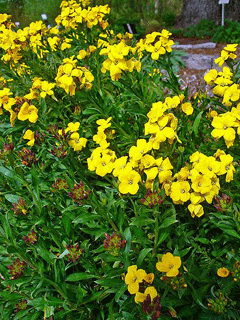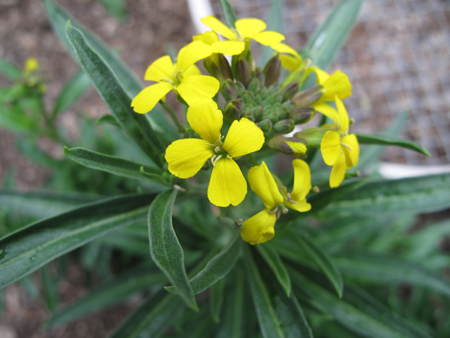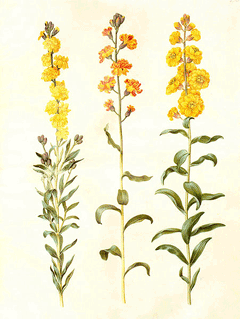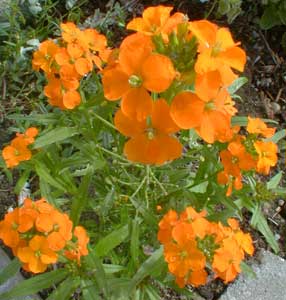Erysimum cheiri
Wallflower ( Erysimum cheiri )
The Wallflower ( Erysimum cheiri ) is a worldwide planted as an ornamental plant species of the family (Brassicaceae ), which was formerly operated under the name Cheiranthus cheiri. The name refers to the original flower color of the plant. In the language of flowers wallflowers represents longing or " I yearn for you."
Features
The gold paint is a perennial plant, reaching heights of growth from 20 to 60 cm. The Stems are erect to ascending, and at the bottom of lignified ( Chamaephyt ). The lower leaves are long in a rosette and up to 10 cm. The petiole is short, the leaf blades are lanceolate and carry twin hair. Urged the leaves along the stem axis are, are much smaller and almost sessile.
The inflorescence is a cluster and consists of 10 to 30 flowers. These are mm quite large, golden yellow, with gardens as well as brownish, and very fragrant with a diameter of 20 (rarely to 25). The scar is deeply bilobed, the lobes are curved back later. Pollination is by bees and bumble bees, flowering time is in Central Europe, May to June.
The fruit is a pod, she is hairy, 2.5 to 6 cm long, is now maintained and is compressed from the back. The width ranging up to 3,5 mm.
Because of cardioactive cardenolides ( Cheiranthin ) the plant is poisonous.
Ecology
The flowers are fragrant " nectar leading stem plate flowers "; her crown is to brown ( or reddish ) in the wild-type yellow-colored golden by the interaction of the red anthocyanin cyanidin with various carotenoids. Two nectaries at the base of the short stamens divide the nectar from the juice serving as holder Kelchblattaussackungen. The fruits are pods wind spreader. The plant itself is a Kulturflüchter.
Dissemination and locations
The gold paint is original in Southeastern Europe, particularly native to the Mediterranean region, where it grows in the wild in rock corridors. In Central Europe, however, gold paint is now overgrown in places and naturalized archaeophyte, which occurs primarily in warmer locations in Central Europe, but for now just scattered. Nevertheless, the gold paint is also in the propagation.
History
The gold paint was mentioned by several ancient authors, and found his scent because many of the violets. According Central Europe, the gold paint came in the 12th or 13th century. He is mentioned by Albertus Magnus and mapped around 1410 in the painting " Garden of Eden ". In the 16th century the species was already widespread. First -filled forms are known from the garden of 1570 by Matthias Lobelius, and since the 18th century it is also brownish forms. The low and branching bush coat and the tall, unbranched rod paint: As a result, a number of other varieties that were divided into two groups developed.
Use
Rod paint was a cut flower temporarily commonly used in the 19th and 20th centuries; at the turn of the 21st century, it lost its importance as a cut flower. His importance as a garden plant has decreased considerably in the meantime in Germany, and it is now used only as an ornamental plant. Previously, however, we used the flowers, the seeds and the herb of gold paint as a medicinal plant, including against skin itching, ulcers in spleen diseases, and to promote menstruation and childbirth. From wallflower blossoms a face water was prepared.









